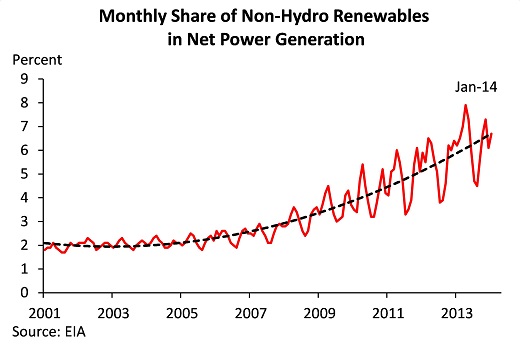 Neil deGrasse Tyson stares at the Sun. Don't try this at home, unless you, too, are a professional astronomer.
Neil deGrasse Tyson stares at the Sun. Don't try this at home, unless you, too, are a professional astronomer.In this week’s episode of Cosmos, Neil deGrasse Tyson dug deep into the science of climate change, and offered his vision of how we can solve it. Dismissing a common climate change denial talking point, he explains:
The sun isn’t the problem, but it is the solution, and we’ve known this a long time. Much longer than you might think.
From there, he jumps to Augustin Mouchot’s demonstration of a solar engine at the 1878 Universal Exposition in Paris, and argues for a solar-fueled future for our society. Curious about Mouchot and that early history, I checked my copy of John Perlin’s Let It Shine: The 6,000-Tear History of Solar Energy (sent as a review copy, but as yet unreviewed). Mouchot himself credited the ancients with solar technology, writing:
One must not believe, despite the silence of modern writings, that the idea of using solar heat for mechanical operations is recent. On the contrary, one must recognize that this idea is very ancient and in its slow development across the centuries it has given birth to various curious devices.
Those included a solar-powered siphon invented in Alexandria in the first century CE, a solar clock which 17th-century Jesuit polymath Athanasius Kircher claimed to have invented, and a statue which Isaac de Caus designed to sing when the sun struck it.
Others took up Mouchot’s idea, which heated water using a solar concentrator, and used the steam to turn an engine. Similar systems are used today as “power towers” for concentrated solar power generation, and for desalination plants in Saudi Arabia.
But that’s not the only way to generate energy from the sun. As Tyson observes, the power generated by wind turbines ultimately traces back to the sun.
In that sense, of course, the fossil fuels we’re burning are also a form of solar energy. Ancient plants and plankton turned sunlight and carbon dioxide into long molecules, and that stored solar energy was buried over time, hidden away, slowly converting into coal and oil and natural gas. There are two problems that come from our reliance on that stored solar energy as a power source. First, expending anything faster than it can regenerate is a sure way to run out, usually at the least convenient time. Second, all that carbon that was stored away long ago is now being burned and released as the carbon dioxide polluting our skies and oceans at epic rates.
Tyson points out that we don’t have to be reliant on that ancient stored energy: “If we could tap even 1% of their power [of wind and waves], we’d have enough energy to run our civilization. And more solar energy falls on earth in one hour than our entire civilization consumes in an entire year. If we could harness a tiny fraction of the available solar and wind power, it could supply all our energy needs forever, and without adding any carbon to the atmosphere.”
So why isn’t that important work happening? Part of the problem is the entrenched power of climate change deniers, and the energy companies that fund them. A recent episode of Years of Living Dangerously followed Heartland Institute PR flack James Taylor as he lobbied lawmakers in Kansas to repeal the state’s policy mandating that a certain fraction of electricity be generated by renewable sources. The repeal would take resources away from farmers and ranchers whose family farms have been saved by wind farms, and would have taken Kansas off the path to confronting climate change. Taylor pressed ahead, denying that climate change poses a risk, and insisting that clean energy is bad for Kansas. He failed there, but similar efforts appear close to success in Ohio and will carry on from state to state, standing athwart history shouting: “No.”
They’ll do the same to block the clean air rule just announced this week, which requires a 30% cut in carbon dioxide emissions by 2030. Such policies help demonstrate the real cost of fossil fuels, and encourage development of cleaner alternatives, so the people who produce or rely upon the dirtiest energy are lined up against the change.
But denial and political wrangling aren’t the only obstacle. There are scientific and technical challenges to overcome, as well. Converting sunlight into usable energy isn’t as easy or as efficient as we’d like. Even plants, which have been at it for a long time, average under 1% photosynthetic efficiency. Once you generate electricity from the sun, it’s hard to store and move to the places where we need it (for instance, in cars and trucks, or places where the sun isn’t shining). But with such an excess of solar power available, we can afford to be inefficient, and as Tyson observes, when we set our minds to a grand task (as with JFK’s challenge to fly to the Moon), we can do almost anything.
Unfortunately, the comparison to the Apollo program highlights just how grand a challenge we face. In today’s dollars, going to the Moon and back cost us about $100 billion. In 2009 the American Recovery and Reinvestment Act—generally known as the stimulus bill—poured money into the clean energy industry. In just two years, the act pushed $27.2 billion dollars into research and deployment for clean energy technologies and improvements in energy efficiency. Another $21.5 billion went into improving energy distribution. Billions more were dedicated to improving vehicle efficiency and improving access to public transportation. And that doesn’t even count private R&D and funding through non-stimulus governmental sources.
 It paid off. In introducing the new rules, President Obama touted the last few years’ tremendous progress in boosting production of renewable power and increasing energy efficiency, even as the economy has grown out of the recession he inherited. We made real progress. But we aren’t halfway to the moon.
It paid off. In introducing the new rules, President Obama touted the last few years’ tremendous progress in boosting production of renewable power and increasing energy efficiency, even as the economy has grown out of the recession he inherited. We made real progress. But we aren’t halfway to the moon.
There are huge discoveries still to be made. The New New Deal, a fascinating history of the 2009 stimulus by Mike Grunwald (full disclosure: we went to high school together), opens with a tale from the early days of ARPA-E, the Department of Energy’s internal magic factory. Secretary of Energy Steven Chu was looking for a way around the inefficiency of photosynthesis (and production of biofuels by algae or plants). “Photosynthesis,” Chu complains to Grunwald, “is too damn inefficient.”
The ARPA-E team, with fresh blood after the election, and a massive influx of cash thanks to the stimulus, realized that they didn’t need to look to plants for the solution, and turned to extremophile bacteria from hot springs and deep sea vents. “Some of those organisms had evolved to absorb energy without photosynthesis, subsisting on hydrogen, ammonia, or even electric current,” Grunwald explains. In October 2009, a researcher at ARPA-E proposed adapting those bacteria to turn an electrical current into liquid fuels. At the time, there was no term for this concept, and indeed no one seems to have ever thought of the idea before. By April 2010, there were 120 grant proposals to research electrofuel development, as it had become known. Less than a year later, ARPA-E chief Arun Majdumar told attendees at the ARPA-E Innovation Summit about the progress they’d made in just a few months:
If you take sunlight, if you take carbon dioxide and water, and combine them in plants in various forms – sugar cane, corn, algae and cellulose – you can get oil.…But you’ve also got to realize that this is less-than-1-percent efficient, which means you need the land and you need a lot of water.
So we in ARPA-E started thinking a little bit differently about this. We said, is there a better way; is there a different way of doing business? And so we created a program for electrofuels. This word does not exist in any dictionary yet… Well, you take electricity from wind or nuclear or solar, or the waste product of oil and natural gas that you throw away…and you take carbon dioxide and use non-photosynthetic microbes…and produce oil. And this process is more than 10 percent more efficient.
And if you think that this is in the future 10 years from now, all that, science fiction, think again. This is a bottle of oil – this is electrofuel being formed by a group in North Carolina State University, combined with OpX Biotechnologies – both ARPA-E-funded – and it’s producing oil.
And if you think that’s the only one, here’s the one produced from MIT.…These are the first electrofuels that have been made using non-photosynthetic microbes.
Elsewhere, entrepreneurs are succeeding using more traditional biofuels. Solazyme, thanks in part to backing from the stimulus and by large purchases from the US Navy and United Airlines, is hacking bacteria to make liquid fuel from sunlight. “We’re leveraging evolution,” CEO Jonathan Wolfson told Grunwald. “We take what the planet is good at making, plant sugars, and turn it into what the planet needs, oils.” Not just fuel oils, either. Solazyme makes most of its money producing oils used in cosmetics and foods.
These exciting areas of innovation—both ripe for classroom discussion—share two key elements. Like the Apollo mission, the computer revolution, and the Internet, they needed (and still need) helpful government policy to succeed. And in both cases, researchers are pursuing solutions to climate change inspired by their understanding of evolution, how life already evolved to solve the problems we face, and how we can shape its future evolution to meet our needs.

